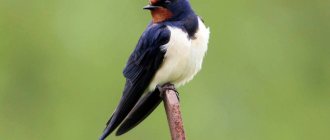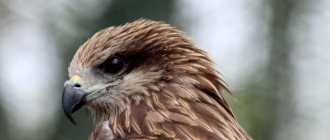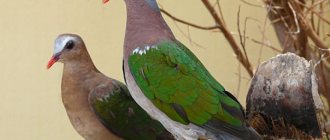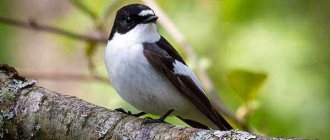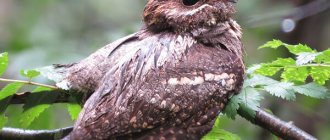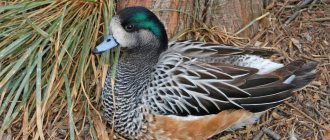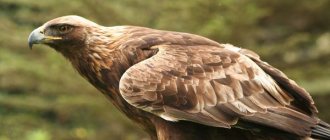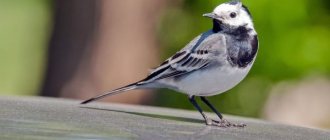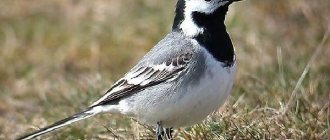Appearance
Photo of a swallow before the flight begins
– Advertisement –
These are small birds characterized by an elongated narrow body; a short thick beak with which the swallow captures insects in flight; narrow wings and a long tail. Due to this, it is easy for the bird to maneuver; in flight, swallows reach speeds of up to km/h. and make long flights without getting tired.
Despite the fact that there are up to 120 species of this bird in the world, they are similar to each other in a number of general characteristics:
- the color of the feather in the upper part of the body is black;
- convex chest;
- large mouth;
- beak shortened;
- the plumage is thick and fits tightly to the body;
- The paws are short, the claws are long and tenacious.
Origin of the species and description
Photo: Swallow Author: Svetlana Medvedeva (@msvetlana012018)
The swallow is a small bird belonging to the family of the same name. It belongs to the passerine order. Initially, such birds lived high in the mountains, but over time they adapted to life near humans. Swallows live in villages and easily adapt to difficult urban conditions. Based on their habitat, they are divided into several species.
Only two are best known:
- Urban;
- Village ones.
The first type is very common in countries with temperate climates. These white-breasted birds build their nests, easily obtain food and breed among multi-story buildings. Village killer whales live closer to people. They often make their nests in the attics of residential buildings, barns, and cowsheds. At the same time, they are not at all embarrassed by such close proximity to people. City and village swallows differ from each other not only in their habitat, but also in appearance. The village ones have a pale beige underparts, the urban ones have white plumage below and a white rump.
Video: Swallow
If we talk about the description of the bird, we cannot fail to note its unique ability for fast flight. Swallows move through the air very quickly. The special natural structure of the body helps them in this. They have a long tail, a small streamlined body, narrow and strong wings. This bird is also easy to recognize by its characteristic plumage. She has a dark blue body that shines pleasantly in the sun.
Interesting fact: Members of the swallow family spend most of their lives in the air. They are very rarely seen on the ground. In the air, these birds learned not only to get their own food, but also to sleep and mate for procreation.
Females and males: differences
Female and male swallow photo
Sexual demorphism in swallows is weakly expressed. The plumage color of females is paler than that of males. In addition, the tail of female swallows is shorter than that of males.
— Advertising —
There are no differences in plumage color between chicks and adult birds.
Do swallows' nests eat
In restaurants with exotic Asian menus, chefs prepare soup from “swallow’s nest.” But in fact, the homes of swiftlets are used for this dish. They look like swallows and live in southern Asia.
The finished dish resembles a soft jelly-like substance. The nests consist of bird saliva, which contains up to 70% protein. Therefore, the soup is sticky and has a sweetish taste.
Not all exotic lovers can afford the dish. Bird houses are difficult to obtain, so their cost ranges from 160 to 650 thousand rubles. for 1 kg.
In restaurants, the price of a bowl of soup ranges from 2.5 to 6.5 thousand rubles.
Why is it called that?
Photo of swallows Birds
rarely fall to the ground, and even then they do it in order to collect building material for the nest. Basically, swallows tirelessly circle in the skies. The initial part of the word “lasta” is translated from Old Slavic as “flying back and forth.” That is, the swallow bird reflects the lifestyle of this bird - it spends 95% of its life in flight. Other names for the tiny bird are “gusset”, “lastovka”.
Features of character and lifestyle
Photo: Swallow
Swallows can lead both a sedentary and nomadic lifestyle. If birds live in areas with a warm climate, then they do not fly anywhere for the winter and lead a sedentary lifestyle. In another case, swallows are forced to make long flights to winter in more acceptable conditions. The migration process is a rather difficult stage for a small bird. Swallows are forced to migrate twice in one year.
The lifestyle of these animals is quite active. They rarely rest, are constantly in search of food for themselves and their offspring - and all this is in the air. For this reason, swallows have poorly developed, weak, short limbs. Their paws are not adapted for moving on the ground. They rarely get that low and walk on the ground. The only exception may be the process of collecting material for building nests.
Swallows can fly both very low and high. They are very fast. In this regard, they are second only to swifts, with which people often confuse them. Swallows can reach flight speeds of up to one hundred and twenty kilometers per hour. The character of these birds is not warlike, but rather peaceful. For example, even if a stranger settles in their nest, the swallow will not attack, but will simply hover restlessly around the house. If this does not scare away the uninvited guest, then she will simply begin to build a new nest nearby.
Lifestyle
Swallows fly to the southern regions photo
Swallows are migratory birds . They are the very first to leave their nests to migrate to warmer areas. The shorebird nests in the northern hemisphere - Europe, Asia and North America. In winter, it migrates to East Africa, Saudi Arabia, and Latin America. Barn swallows breed in North America, northern Europe and central Asia, as well as the Middle East and North Africa. For the winter they fly to South America, South Asia, and Indonesia.
Representatives of the red-rumped species are common in Eurasia and Africa. Also nests in North African countries. Residents of the northern regions fly to South Africa and South Asia for the winter. Swallows fly away when the average temperature reaches +10 degrees. They migrate in flocks of up to 1,000 individuals. A flock flies during daylight hours. For the night, it descends into swampy places and spends the night in reeds. Families of swallows stay close during migration. If a family member is lost, he finds “their people” by voices that he can easily recognize.
Some species of swallows that live in the southern regions lead a sedentary lifestyle. During the winter, they insulate their nests and stock up on food. They live in colonies of 20-30 pairs, placing their houses close to each other.
Features of behavior
Photo of a blue swallow
Swallows are constantly on the move and rarely rest. Having highly developed wings, they have practically no control over their limbs. It is difficult for swallows to move on weak, short legs, so they rarely land on the ground. The only reason why they can approach the ground is to collect building material for building a nest.
In flight, the speed of a swallow bird is up to 160 km/h . Birds fly quickly, they are dexterous and nimble. In this they are similar to another bird - the swift, its speed is up to 200 km/h. Many people do not know the difference between a swallow and a swift and often confuse the birds. The difference between a swift and a swallow is that the former does not fold its wings in flight. Swifts are also known for their loudness.
Swallows are friendly, peace-loving birds. They can coexist with other bird species. Even if a stranger has settled in the swallow’s nest, she will not attack him, but will build herself a new house.
Swallow's nest
Photo with swallow chicks and female swallow.
Different types of swallows arrange their nests in their own way. Thus, the nest of a killer whale (barn swallow) resembles a quarter of a bowl. The bird attaches a semicircular wall to the surface of a wall or roof. The swallow builds a nest of such a size that it can accommodate the brood and itself.
Rufous-rumped swallows build large nests. The entrance to the house is located on the side and looks like a tunnel, slightly widened towards the exit, or a pipe.
Living funnels select openings between the eaves and the brickwork. In a place protected from the winds, spherical nests are made. The home is closed on all sides. A small round inlet is located on the side at the very bottom.
Swallow collecting nesting material photo
To build housing, swallows use lumps of earth (mostly clay) moistened with their own saliva. Saliva acts as glue, so the dugout is strong and durable. Sometimes blades of grass are woven into the design. The birds begin building the nest in mid-May. Construction ends in 8-10 days. By this time, the female is ready to lay eggs. The swallow bird, the photo you can see above, covers the bottom of the nest with hairs, feathers, moss and other soft, warm material. This is necessary to warm the naked chicks.
Nests are built predominantly by females. The male helps in the construction - he carries lumps of dirt and puts them in a pile so that the female builds the house without stopping. Construction material is collected from a distance of up to 250 meters.
In ravines along rivers you can often see swallows making a nest between folds of loose rock. These places are called nesting grounds. City swallows prefer close proximity, while country swallows build houses far from each other.
Swallows use nests for several years in a row. If necessary, they repair it, re-equip it, remodel it. When birds fly away for the winter, their homes are looked after by sparrows, forest dormice, whirligigs and even wasps.
Reproduction
Little swallow chicks photo
Swallows are monogamous birds. They create a family with one partner and then raise their common offspring together. The mating season begins in May. At this time, the male swallow spreads his tail and sings short, sonorous songs, thus attracting the female he likes.
Partners mate in the air. Mating games last on average 10-14 days. Then the flock calms down - the period of incubation begins. Hatching occurs within 14-16 days. The female lays up to 7 tiny eggs at a time.
The shell is painted white with numerous brown inclusions. It is noteworthy that not only the mother, but also the father incubates the cubs.
Cubs appear in mid-June. If you look at the photo, you can see that swallow chicks are tiny (size - 1.5-2 centimeters, weight - 1.7 grams). The skin is pale blue, there is a rare light fluff.
Over the next three weeks, parents feed their offspring, which, by the way, are voracious. Swallow chicks eat the same food as their parents - animal protein. At three weeks of age, the chicks make their first flight. Then, having learned to pilot, they leave the parental nest in early July.
Swallows live on average four years. With a sedentary lifestyle, some manage to live up to 8 years. Sexual maturity in females occurs a year after birth. For the first time, a young female gives birth to a small number of offspring; each subsequent time the number of eggs in the clutch increases. During the season, the swallow makes two clutches - in June and early September.
What do they eat?
A female swallow feeds its chicks.
The bird needs a lot of energy to fly endlessly. Therefore, swallows consume a lot of protein. Swallows feed mainly on flying insects , including mosquitoes, flies, fleas and other types of insects, so they are useful for humans. The bird mainly catches prey in flight, and is able to feed its chicks on the fly. Swallows also eat plant foods, but they make up 5% of the diet.
Birds hunt for prey in the air. Seeing the victim from afar, they rush with sudden movements, catching up with “lunch” in no time. The mouth captures the insect completely. The developed digestive system makes it possible to eat not only soft-bodied creatures, but also beetles with hard shells.
The mother swallow also feeds her young in flight. Grabbing a tiny insect, it flies up to the babies and puts food in their mouths.
Swallows hunt at a height of 5-10 meters, flying around bodies of water - where a concentration of flying insects is concentrated.
Types of swallows with photos
The most common types are:
Barn Swallow (Hirundo rustica)
This species is distinguished by its black dorsal area with a bluish tint. The wings are painted the same color, while the chest area and abdomen are distinguished by a whitish-pink tint. This type of swallow is popularly called “killer whale.” As a rule, for nesting sites they choose areas located near human habitation. They build nests under the roofs of both residential and non-residential buildings, as well as various outbuildings. They arrive after the end of the winter period, with the onset of spring warmth.
City swallow (Delichon urbicum)
This species differs from barn swallows in having a lighter belly. The city swallow, or "swallow" as it is popularly called, is more common in colder, northern regions.
Ground swallow
Or common swifts differ from the rest of their relatives in that they use earthen burrows dug on their own as nests. It should be noted that their life mainly takes place in flight. They descend to the ground to lay eggs and then feed their offspring.
Tree swallows (Tachycineta bicolor)
This species of swallow is characterized by the presence of very bright black plumage, with a very attractive purple tint.
The swallow swallows are the most interesting because they live exclusively within South America. This species of swallow is also interesting because the birds lead a sedentary lifestyle and do not fly anywhere, compared to many other species.
It is important to know! The purple wood swallow, which lives within North America, is considered the largest, since its body length is about 20 cm. Due to the fact that the chicks of this species have a purple color in their plumage by winter, this species received this name.
Antcatcher swallows primarily feed on colonies of tree ants, although their diet includes other insects in addition to ants. These swallows have quite strong and sturdy legs.
Natural enemies of swallows
Even though the swallow appears to be a fragile creature, it does not allow itself to be offended. Thanks to its lightning-fast reaction and speed, not every predator is able to catch up with it. With rare exceptions, the swallow becomes the prey of mammals. For example, the lunch of a fox or a wolf becomes swallow chicks that accidentally fell out of the nest. Or an adult swallow ended up on the ground due to a wing injury.
Often the cause of the death of swallows is not other birds or animals, but bad weather conditions. It happens that when migrating to wintering grounds, entire flocks die due to cold, wind, and rain.
The only bird that swallows are afraid of is the hobby falcon - a dangerous enemy of the little bird, because it is as nimble and dexterous as a swallow. The falcon hunts near bodies of water: when the swallow is busy looking for food, it becomes inattentive and falls into the tenacious claws of the falcon.
The enemies of swallows are parasites - ticks, fleas, malaria. Harmful insects settle in the feathers and skin of birds, infecting them with diseases.
What do swallows eat in the wild?
Regardless of the area where swallows live, their characteristic feature is feeding on insects. Even in bad weather, which does not allow them to rise high into the sky, swallows do not choose other types of food like other birds. They practically do not feed on plant foods or larvae. The share of plant elements in their diet is no more than 5%.
All this causes difficulties that arise during periods of lack of food. Thus, swallows in winter suffer greatly from lack of food, which is why wintering is a necessity for them.
Typically, swallows prefer to feed in an area within a radius of 500 meters from their nest. Birds easily catch prey in open space, including fields or mountain slopes.
The diet of birds consists mainly of mosquitoes, flies, beetles, butterflies, and dragonflies. Before the pressure rises, the insects move close to the ground, forcing the swallows to move lower. At this point, the birds descend low enough for people to determine emerging weather conditions by their behavior.
Not every time the behavior of swallows allows us to reliably judge the characteristic features of the weather. Even in good weather, especially in the evening, swallows can descend close to the ground, since a large number of insects are present in this place. Birds search for insects not only in the air, but also on the ground.
Swallows hunt at an altitude of up to 10 meters and are carried out mainly near bodies of water where there are a large number of flying insects.
Birds require large amounts of energy to fly for long periods of time, which requires them to consume large amounts of protein. The swallows' diet largely consists of harmful insects such as mosquitoes and fleas, which makes the birds extremely useful for humans.
Hunting for prey in swallows is accompanied by sharp, fast movements, with the help of which they quickly catch up with the prey. A good digestive system allows the swallows’ body to quickly cope not only with soft insects, but also to digest beetles with hard shells.
Spreading
Area
Numerous populations of swallows are found on all continents, with the exception of Australia, the polar regions and the northern temperate zone.
Place of residence: southern countries. Asia, Africa, Southern Europe - the weather conditions of these countries allow for a sedentary lifestyle. In addition, there is a lot of food there.
Distribution areas of the swallow family:
- Northern Europe. The exception is Scandinavia, the Kola Peninsula;
- North, South America. In the North these birds live and breed, in the South they winter;
- Africa. They nest in the north of the continent;
- Middle East, China, Japan.
Habitats
City swallows prefer to settle in cities, among stone buildings. Families live under the eaves, creating multi-room noisy apartments there. Barn swallows prefer to live away from urbanized areas. The habitat chosen is small settlements and undergrowth. Coastal species live in ravines near water bodies.
Initially, swallows lived only in rocky areas, but later they adapted to life in settlements and undergrowth. These are patient, hardy creatures that adapt to any terrain and climate. The main thing for a swallow is the availability of food and a place to build a nest. Swallows can be found in the city, near rocky caves, at the edge of the forest, and more often along lakes and rivers.
How do birds live?
Another main and remarkable feature of swallows is migration. They fly away before the onset of cold weather, and return around mid-May, after which they begin building nests and raising offspring.
Note!
- Parrot: tips for choosing, the best breeds and rules for training different types of parrots (100 photos)
Eagle bird: description, species, lifestyle, habitat and interesting facts about the bird of prey (95 photos)
Parrot cage - features of choice
Solitary swallows are rare, are social birds in their own right, and small flocks are more often seen.
Favorite places are near water bodies. All thanks to the presence of a huge supply of food and tools for building a “house”.
They often defend their own nest to the last, and leave it only in extreme cases.
Keeping at home
Swallow in a person's hand photo
These cute birds end up in human hands for various reasons: for example, an adult bird has broken its wing and cannot fly with its family for the winter, or a chick has fallen out of the nest and has no chance of survival. This is how swallows become pets quite by accident. Finding yourself alone with a helpless, squeaky baby swallow, many do not know how to care for and what to feed the chick. Keeping a swallow at home is not an easy task. Living in a cage, the bird itself will not look for food and ask for food. Therefore, you will have to feed her yourself.
What to feed a baby swallow
Feeding a swallow photo
If the chick is very tiny, then for the first days it is fed with a dairy product (cottage cheese, milk) from a pipette. Grown-up chicks and adult birds are fed simple raw or boiled lean meat. They make minced meat from the meat and feed it to the swallow. At one time, the bird is fed a piece of food the size of a walnut. They feed only during the daytime.
Swallows are fed every 2-3 hours and only with fresh food.
Sample menu for a baby swallow:
- a pinch of low-fat cottage cheese + a spoonful of insects + dry gammarus (fish food) or daphnia. Mix everything, form a tiny ball and put it in the bird’s mouth;
- boiled egg + carrots + crackers. Grind the ingredients, mix, form a ball;
- Swallow chicks should not be fed eggshells, bread crumbs, or food intended for pets.
If you do not regularly give a complex of vitamins, then soon the chick’s feathers will begin to fall out, bone deformation will occur and the functioning of the stomach will be disrupted. Improper nutrition leads to the rapid death of a pet.
If you manage to release a young bird, it will probably no longer want to live in the wild, but will prefer to stay with a person. A human-fed bird will die in the wild.
House swallows are kept in spacious cages or aviaries - after all, swallows like to be in constant motion. Some birds become so accustomed to people that they may take a liking to a garden tree branch or perch.
Number
The swallow population consists of several tens of millions, and the number remains at a stable level. That is, this species is not in danger of extinction. Swallows are very useful for nature because they destroy harmful insects.
Swallows get along well with people. People do not drive away swallows and allow them to build nests near their homes. Swallows, in turn, protect gardens from harmful insects. We can say that swallows and people build relationships on a mutually beneficial basis.
If you find an error, please select a piece of text and press Ctrl+Enter.
Interesting Facts
Swallow in flight photo
- There are 120 species of swallows in the world.
- Swallows are insectivorous birds. Flies, mosquitoes, butterflies, bugs - this is only part of what swallows feed on.
- A swallow feeds on the fly.
- Swallows living in the city are not afraid of humans. They often settle under the eaves of houses, on balconies.
- Swallows have developed vision, which helps them see a tiny insect at a long distance and rush in pursuit.
- The swallow is constantly busy searching for food. Swallow chicks eat up to 300 times a day!
- Swallows not only eat in flight, but also drink, mate and even sleep.
- Swallows live 4-8 years.
- The swallows' home is passed down from generation to generation.
- The barn swallow is the national symbol of the Republic of Estonia.
- The barn swallow is depicted on the Slovenian 2 tolar coin.
- Among the swallows there are mother cuckoos. They lay eggs in someone else's nest or move them while the owner of the other nest is not around.
Folk signs about swallows.
The significance of swallows in folklore is great. There are many folk signs and ideas associated with this bird. For example, in Russia the swallow represents prosperity, tranquility and peace, while in Ireland this bird is read as the “devilish spawn”.
Common signs
Swallow sitting on a branch photo
- The swallow has built a nest under the roof of the house - fortunately. This means that the swallow has chosen a kind family to live in, and living next to it is peaceful. Where there is a nervous atmosphere, the swallow will not settle.
- The swallow left the nest, which it had built under the eaves of a human dwelling - a bad sign, meaning losses, disappointment.
- Swallows fly low - it means rain. This belief is explained as follows: before the rain, the flies on which swallows feed descend to the ground. Therefore, the swallow also has to fly near the ground in search of food.
- To destroy a swallow's nest or kill the bird itself is to invite misfortune, hunger, and disease upon oneself.
- A bird flew into the house through a window - a sign that only foreshadows a bright future. In this case, the swallow cannot be kicked out: it must be fed and waited until it flies out the window.
- Hearing swallows singing is a good omen. At this moment you need to wash your face with milk - to cleanse yourself of sins.
- Villagers believe that if you intentionally kill a swallow, it will lead to the death of livestock.
- When you see the first swallow in the spring, feed it. This will bring prosperity to the house.
- Swallows circle over the heads of the newlyweds - to a happy family life.
- The first swallows arrived in early spring - for the harvest year.
Why do you dream about a swallow?
Rufous-rumped swallow photo
It is believed that the swallow is a symbol of change and renewal. If a swallow circles overhead in a dream, this means that news from relatives awaits you. A flock of swallows dreams of unexpected but pleasant news. Seeing a swallow separated from the flock and flying straight towards you means meeting an old friend.
Seeing a bird sitting in a nest means a calm future; troubles will be avoided. If a bird hatches eggs, wealth will come soon. Swallow chicks dream of an early easy pregnancy.
A swallow lands on your shoulder - positive changes are expected. An unmarried girl will soon get married, a lonely girl will find a suitor. In such a dream, careerists can hope for a quick promotion or increase in salary. Holding a swallow in your hands means wealth, a comfortable and happy life.
Swallow bird tattoo means youth, prime of life, good luck. In addition, for women, the swallow symbolizes motherhood, procreation, and care for offspring. Young people place similar tattoos on the clavicular depressions or shoulder blade.
How to keep birds away from your home
Since ancient times, people have believed that swallows making nests are a sign of happiness and comfort in the home. However, not everyone will be happy to have birds under the roof of their home due to the noise and large number of feathers. Therefore, they try to scare away the birds and destroy their nests.
Russian zoologist Vladimir Wagner, during experiments, concluded that the location of the nest is important to swallows. If they have chosen a certain area, they will fly there every spring.
Birds are ready to feed even other people's chicks if another family has occupied their nest.
There is no use in destroying bird houses. The birds will build them again in the same place. They will only stop building a nest if the walls are slippery. In this case, the birds will not be able to fix the mud balls.
Singing
Swallow singing photo
Swallows are characterized by a quiet chirping sound. The songs of swallows do not stop throughout the summer. Researchers distinguish up to 6 chirping sounds in birds: “vit”, “vi-vit”, “chivit”, “chirivit”, etc. Often in the middle of the song the male inserts a loud “cerrrrrrr”. Swallows love to sing in duets. Females have a shorter song.
When communicating with each other, you can often hear the cry “chvit”. This sound is transmitted by a flying swallow to its chicks or partner. This “chwity” is especially noticeable during the period of building a house and nursing the cubs.
When hunting for insects, swallows make “tweak tweak” sounds. The male warns of danger with a drawn-out “mmiu” or a sharp “ki-ir”.
Quiet chirping - “vit”, “vi-vit”, “chivit”, “chirivit”, etc. I hear swallows all the time. The song consists of soft, pleasant chirping sounds, among which a crackling phrase like “cerrrrrrr” is often inserted. A male and a female sing, sometimes in a duet; the female's song is shorter.
Reproduction and raising of offspring
Recommended by topic
Zebra Swan Salamander
Swallows are considered monogamous birds, creating pairs once and for all. However, the behavior of some males is polygamous, which is why they can breed offspring with several females.
It often happens that a female, who already has a partner, arrives from the wintering grounds before him and is busy repairing their previous home. After some time, the male also returns from wintering. If at this point the nest turns out to be unfinished, the couple organizes a joint watch, during which one family member searches for building materials, and the other uses available items to eliminate problems with the nest.
After mating, swallows lay up to 5 eggs at a time. The eggs themselves are white and weigh no more than 2 g. Hatching lasts about two weeks, although sometimes this process can be delayed for a longer time due to unfavorable weather. Usually the eggs are incubated by the female, to whom the male brings the caught prey. When the weather in the region is rainy, it becomes more difficult to find food for two, and the female has to look for food on her own while the male replaces her.
Question to the expert
How long do swallows live?
The average lifespan of swallows is about 4-5 years. However, some individuals in the wild are able to live up to 8 years, although this figure is rather an exception.
Caring for chicks
Swallows' offspring are usually born closer to mid-June. The chicks are born very tiny: no more than 2 cm and weighing 1.5 g. They have pale blue skin with a small amount of light fluff. In about a month, sometimes a little earlier, the chicks will get stronger and feel confident enough to fly on their own. So, at the end of July, the chicks are ready to leave the parental nest. However, for some time, usually about a week, parents continue to feed their mature offspring.
The babies are born very weak, which is why swallows sometimes have to break the shell of their eggs so that they can emerge.
After the babies are born, the male and female take turns feeding the offspring, which constantly requires food. Their diet, like that of adult parents, consists mainly of animal protein.
Sexual maturity in older females occurs already in the first year of life. Their first offspring are usually quite small in number, but each subsequent year the number of eggs produced gradually increases. In one season, a female can lay two clutches: one in June, the other in early autumn.
Art
The motif of the swallow bringing spring (or day) is found in numerous stoneflies, carols and corresponding spring rituals, which are also reflected in the visual arts.
The arrival of a swallow is depicted on the Greek pelike of Euphronius from the end of the 6th century. BC e. accompanied by the text:
- “Look, swallow!”; - “Yes, swallow, I swear by Hercules”; - "Here she is! It's spring already".
There are numerous examples when the swallow acts as a symbol of danger, fragility and unreliability of life, happiness, and comfort. These symbolic meanings of the image of a swallow are developed in literature and art right up to modern times:
“The blind swallow will return to the palace of shadows on cut off wings” - O. E. Mandelstam about a forgotten word that needs to be said.
The poet Veke uses this symbol to convey the pathos and inexorable nature of time, drawing analogies with other symbols (???).
Ad vocem
Puzzles:
- “I’m small, but I’ve been overseas.”
- “Shitovilo-Bitovil spoke German” - the swallow as a symbol of a talkative woman.
Proverbs, sayings, signs, symbolism:
- “The swallow begins the spring (day), but the nightingale ends.”
- “Whoever washes himself with milk at the first swallow will be white.”
- "Early swallows - for a happy year"
- "High-flying swallows - to the bucket."
- "The first swallow."
- “One swallow (still) does not make spring” - found already in Aristotle and Aristophanes.
Mesoamerica
The Island of Swallows or the Land Where the Sun is Born
Tatyana Vitakova To the east of Yucatan stretches the turquoise expanse of the endless Caribbean Sea. From its waves emerges the large island of Cozumel, the easternmost point of the Mayan horizon, the place closest to the rising sun. Therefore, the Mayans called it “the land where the sun is born.” They also liked to call it Ah-Kusamil-Peten - “Island of Swallows”, in honor of the swallow-legged goddess Teel Kusam. The patroness of the island is the rainbow goddess Ish Chel - the wife of the great sun god Itzamna, the protector of women, pregnancy, childbirth, motherhood and women's work. Expectant mothers came to the island on the day 8 Sip, dedicated to this goddess in the Mayan calendar.
About 30 dilapidated temples have survived on the island. The first ancient structure that we were able to see was El Cedral - “The Cedar Tree” - a structure designed for astronomical observations. The stone walls and roof of the Cedar Forest were picturesquely entwined with massive roots of tropical plants. Next to the “observatory” there is a Catholic chapel.
Surprisingly, the Mayan calendar was much more accurate than the Julian and Gregorian! They accurately calculated the duration of the Moon's revolution around the Earth - 29.53059 days. And the orbit of Venus is off by only 20 seconds!
The surviving sanctuaries of the island are mostly distinguished by their extreme simplicity. As a rule, this is a small quadrangular room with a flat roof and a single entrance.
In the south of the island there is an unusually shaped temple - in the form of a shell - El Caracol. Squatting into the small entrance, you can see how the walls of the “shell” twist in a spiral. Near El Karakol I found an ancient jadeite bead - perhaps the pyramid has a burial place.
Karakol - “Spirit Snail” - the oldest ancestor, one of the gods of the underworld - the cave of ancestors, was depicted as an old man sitting in a shell. The space of the ancestral cave was identified with the space of the curls of the shell and personified the Milky Way - the path of the soul in space from birth to death and subsequent rebirth, symbolized by a shooting star. In the first lunar month, a pregnant woman had to go to the pyramid at night to see a shooting star. The Milky Way is the “creator” of all things. At the heart of all Mayan religious and spiritual ideas was the idea of reincarnation - the constant rebirth of the souls of the dead. The sanctuary symbolized the cave of the ancestors and was the main cult place.
© Copyright: Tatyana Vitakova, 2009 Certificate of publication No. 2904080762
Egypt
A bird dedicated to Isis as the Great Mother, as well as to the gods of the hearth, as it builds its nest near human habitation.
A symbol of paternal inheritance, because before she dies, she builds a nest for her chicks.
According to the myth, Isis, in the guise of a swallow, goes to look for the body of her husband Osiris, who was killed and torn to pieces / flutters around the column that covered the coffin of Osiris[1].
Since the 18th dynasty, the swallow has been revered as a sacred animal in Thebes.
Swallows are “eternal northern stars” flying over the River of Life [2].
Along with other sacred birds (falcon, heron, phoenix), the deceased wishes to turn into a swallow so that he “cry like a conqueror in full daylight” [3].
Bibliography
— MNME —
Toporov BH
, Swallow // Myths of the peoples of the world.
Encyclopedia: in 2 volumes / Ch. ed. S. A. Tokarev. — M.: “Sov. Encyclopedia", 1991. T.2 - SMES - Gura A.V.
, Swallow // Slavic mythology.
Encyclopedic Dictionary. Ed. 2nd. - M.: International. relations, 2002 - Jobes G.
, Dictionary of mythology, folklore and symbols, pt 2, NY, 1962, p.
1515-16 < MNME - Henkel A.
, Schöne A., Emblemata.
Handbuch zur Sinnbildkunst des 16. and 17. Jahrhunderts, Stuttg., 1967, S. 872-75 < MNME - Gura A.V.
, Animal symbolism in the Slavic folk tradition. M., 1997. P. 618-633 < SMES
